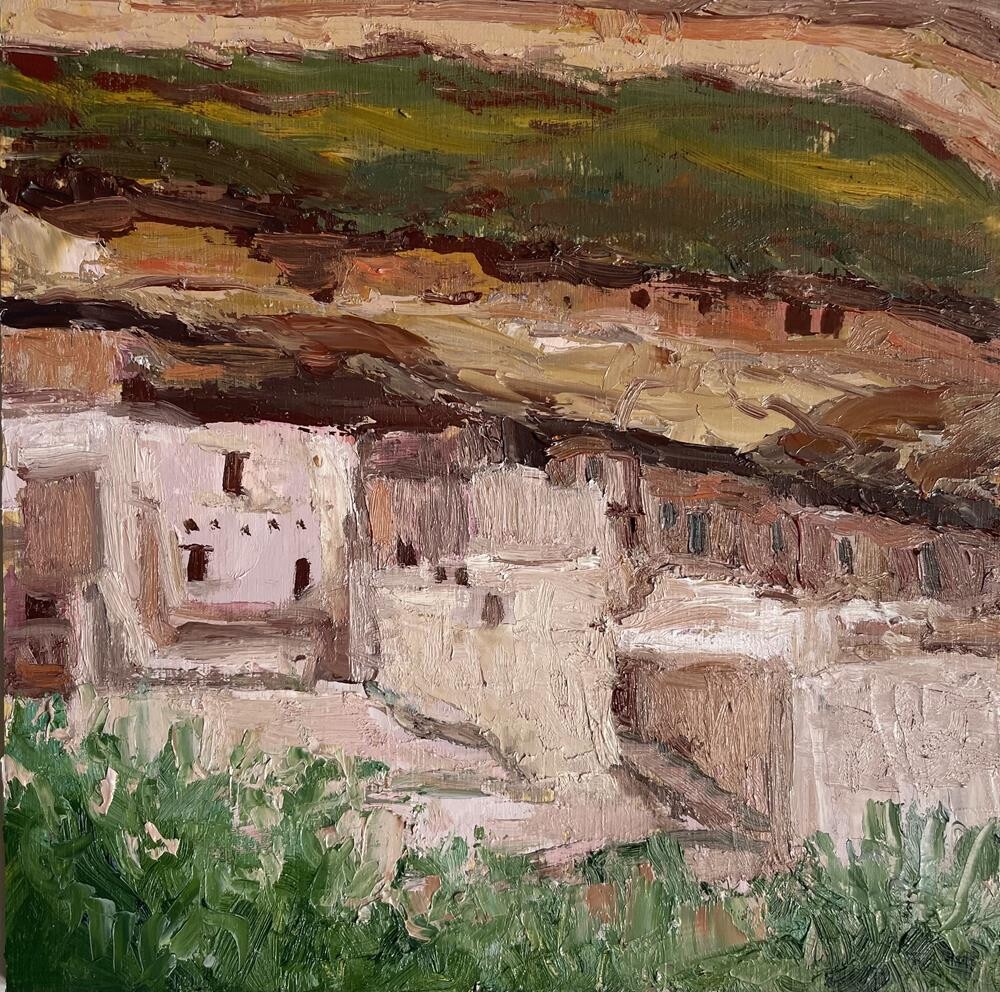Mar 26, 2024
Media: oil on birch panel, shellac undercoat, unframed
Size: 6x6 in
These cliff dwellings, constructed by the ancestors of today's pueblo tribes, are haunting in their beauty. When the sun hits the stones, they seem to glow with a light from within. The original dwellers left long ago, and left a mystery behind them. What happened? The most likely answer is that a long drought made it less and less habitable and so many turned south, although some remained and now live in pueblo communities in the southwest. (I'm not an expert on all this, but love reading about it.) The first time I saw some of these buildings was when I was a little girl. We took our own children to see them twice while on cross-country roadtrips. The second time, we stayed above Canyon de Chelly (pronounced Shay) and went on a tour with a local guide. You can only tour inside with a local guide, because all of the canyon is operated by the Navaho nation, and dozens of families still live within it. That makes it one of the oldest continuously occupied places in the country. The word Anasazi came from the Navaho word for ancient enemy, which is why the Pueblo people prefer the term Ancient Puebloans. The day we went, it had been raining. Our drive turned into an adventure, with us driving through raging torrents of water, once having to use a winch to get out. We saw some amazing dwellings and beautiful landscape, and left just in time. The next groups had to abandon their cars on high ground and climb up out of the canyon. We looked down from the rim above and saw a pedestrian bridge we had crossed was now washed away. Nature calls the shots here. I feel very lucky to have been able to visit these ancient homes. The people's stories live on in the stories of the Pueblo tribes, proving their resilience in the face of impossible odds. These cliff dwellings, constructed by the ancestors of today's pueblo tribes, are haunting in their beauty. When the sun hits the stones, they seem to glow with a light from within. The original dwellers left long ago, and left a mystery behind them. What happened? The most likely answer is that a long drought made it less and less habitable and so many turned south, although some remained and now live in pueblo communities in the southwest. (I'm not an expert on all this, but love reading about it.) The first time I saw some of these buildings was when I was a little girl. We took our own children to see them twice while on cross-country roadtrips. The second time, we stayed above Canyon de Chelly (pronounced Shay) and went on a tour with a local guide. You can only tour inside with a local guide, because all of the canyon is operated by the Navaho nation, and dozens of families still live within it. That makes it one of the oldest continuously occupied places in the country. The word Anasazi came from the Navaho word for ancient enemy, which is why the Pueblo people prefer the term Ancient Puebloans. The day we went, it had been raining. Our drive turned into an adventure, with us driving through raging torrents of water, once having to use a winch to get out. We saw some amazing dwellings and beautiful landscape, and left just in time. The next groups had to abandon their cars on high ground and climb up out of the canyon. We looked down from the rim above and saw a pedestrian bridge we had crossed was now washed away. Nature calls the shots here. I feel very lucky to have been able to visit these ancient homes. The people's stories live on in the stories of the Pueblo tribes, proving their resilience in the face of impossible odds. |


 Email to a Friend
Email to a Friend











































































































































































